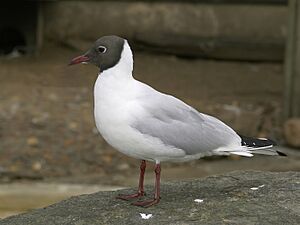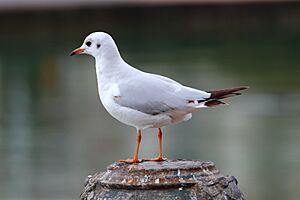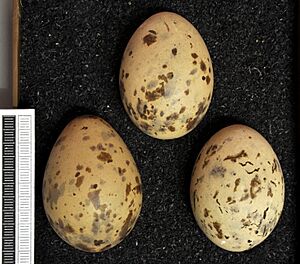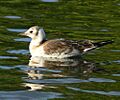Black-headed gull facts for kids
Quick facts for kids Black-headed gull |
|
|---|---|
 |
|
| Adult summer plumage | |
 |
|
| Adult winter plumage | |
| Conservation status | |
| Scientific classification | |
| Genus: |
Chroicocephalus
|
| Species: |
ridibundus
|
 |
|
| Map of eBird reports of C. ridibundus Year-Round Range Summer Range Winter Range | |
| Synonyms | |
|
Larus ridibundus Linnaeus, 1766 |
|
The black-headed gull (Chroicocephalus ridibundus) is a small gull. These birds breed across much of Europe and Asia. They also breed in coastal eastern Canada. Most black-headed gulls travel south for winter. But some stay in the milder parts of western Europe. You can also find smaller groups in northeastern North America.
This gull used to be called Larus ridibundus. But scientists changed its genus name to Chroicocephalus. This new name comes from old Ancient Greek words. Khroizo means "to colour" and kephale means "head". The second part of its name, ridibundus, is Latin for "abundant".
Black-headed gulls show many interesting behaviors. For example, they remove eggshells from their nests. Young chicks also work together to beg for food. Sometimes, females lay eggs in another gull's nest. These gulls are often found in different places during winter.
Contents
About the Black-headed Gull
This gull is about 37–44 cm (14+1⁄2–17+1⁄2 in) long. Its wings can spread up to 94–110 cm (37–43+1⁄2 in) wide. It weighs between 190–400 g (6+3⁄4–14+1⁄8 oz).
When flying, you can spot a white edge on its wings. This is a good way to tell them apart. In summer, adults have a chocolate-brown head. It looks black from far away. Their body is pale grey. The tips of their wing feathers are black. Their bill and legs are red. In winter, the brown head color is gone. Only two dark spots remain. Young gulls have brown spots on their bodies. They also have a black band on their tail. Male and female gulls look the same.
Black-headed gulls nest in large groups called colonies. They build nests on the ground. These nests are often in reed beds, marshes, or on lake islands. In winter, they gather in big groups to feed or rest. They usually stay near coasts. They do not often fly far out at sea.
This gull is a bold eater. It will eat many different things. This includes insects, fish, seeds, and worms. They also eat scraps in towns. In farm fields, they find small creatures. They are noisy birds, especially in their colonies. Their call sounds like "kree-ar." Their scientific name means "laughing gull."
These gulls take two years to grow up. Young gulls have a black tail band. Their wings have more dark areas. In summer, their dark head color is not fully developed. Black-headed gulls can live a long time. One was recorded living for at least 32.9 years in the wild.
Where They Live
You can find black-headed gulls across most of Europe. They also live across Asia to Japan and eastern China. A few also breed in northeastern Canada. In winter, they can be seen in northeastern North America. They travel as far south as Virginia. Sometimes, they are seen with the similar-looking Bonaparte's Gull. They also visit some Caribbean islands. They are very rare visitors to the Carolina coast.
Cool Behaviors
Removing Eggshells
Birds often remove eggshells from their nests. They do this after their chicks hatch. This behavior helps hide the nest from predators. The farther away the shells are, the safer the nest. Black-headed gull eggs are eaten by other birds, foxes, and stoats. Even other gulls can be a threat. Mother gulls try to protect their chicks. But very young chicks can be taken by other gulls. This happens if the parents are not paying attention.
Black-headed gulls also remove other unwanted items from their nests. This cleaning is important. It happens during the time the eggs are hatching. It also continues for a few days after. Both male and female parents help with this task. It usually takes only a few seconds. They do this about three times a year.
A black-headed gull can tell an eggshell from an egg. They look for the thin, jagged, white edge of the shell. The weight of the egg or shell does not matter.
Why Remove Eggshells?
Scientists have thought of other reasons why gulls remove eggshells:
- The sharp edges of the shells might hurt the chicks.
- The eggshell could get in the way while the parent is sitting on the nest.
- A shell might slip over an unhatched egg. This would create a double shell.
- Wet material left from the shell could cause bacteria or mold to grow.
How They Breed
Chicks Begging for Food
Black-headed gulls feed their young by spitting food onto the ground. They do not feed each chick directly. Parents give more food when chicks beg harder. This happens whether one chick begs or many beg together. Young gulls learn to beg together. This helps them get more food as a group. It also saves energy for each chick. More begging means more food from the parents.
The way chicks beg changes as they grow. Usually, they beg 3-5 times per hour. Each time lasts about one minute. Strong begging starts at the end of the first week. But chicks learn to beg together in their last week in the nest. More siblings mean more coordinated begging. This also means less individual begging.
Male and Female Chicks
Male black-headed gull chicks have a lower chance of survival. This is compared to female chicks. In this species, males are usually larger. So, if there is not much food, larger birds are at a disadvantage.
Male chicks are more likely to hatch from the first egg laid. Female chicks are more likely to hatch from the third egg. The mother's condition when laying eggs can affect her chicks. This includes how much food is available to her.
Laying Eggs in Other Nests
Sometimes, a female gull lays her eggs in another female's nest. This is called conspecific brood parasitism. It helps the female avoid the work of raising her own young. Black-headed gulls usually lay three eggs. The first two eggs are often larger than the third. The third egg usually has the lowest chance of survival. The first or second eggs are often the ones laid in another nest.
Most of this "egg dumping" happens early in the egg-laying season. Laying eggs in another nest increases the chance of them hatching. This can happen if a nest is left empty. Or if another bird takes over a nest.
Having eggs from different mothers in one nest can be a problem. The host mother might care for the extra chicks more than her own. This could harm her own chicks. Also, raising more chicks uses up more of the host's energy.
Colony Center vs. Edge
Gulls nesting in the middle of a colony may lay eggs earlier. These central pairs also tend to lay larger eggs. These larger eggs have a higher chance of hatching. Gulls at the edge of the colony lay smaller eggs. Birds in the center are often healthier. They also have better genes.
Walking Styles
Black-headed gulls walk in two main ways. They either bob their heads or they do not. When they bob their heads, it has two parts. First, they hold their head still. This happens when only one foot is on the ground. It helps them balance their head with their surroundings. Then, they thrust their head forward. Head-bobbing helps them see movement and patterns better. It also helps them judge depth when walking through water to find food. When gulls are waiting on flat ground, they walk without bobbing their heads.
Eating Gull Eggs
Some people in the UK consider black-headed gull eggs a special food. They are eaten hard-boiled. The UK government strictly controls collecting these eggs. Only a few licensed people can collect them. This happens at six specific places. It is allowed only between April 1 and May 15 each year. Only one egg can be taken from each nest. No eggs can be sold after June 30. Gulls usually lay eggs in late April and early May. So, the eggs are only available for a few weeks each year.
Working Together
Black-headed gulls watch out for danger together. They synchronize their watchfulness with nearby gulls. How close they are to each other affects this teamwork.
Australian Discovery
On October 19, 1991, a bird watcher named Brian Kane saw a strange bird. He was in Broome, Western Australia. He called the Broome Bird Observatory. They were not sure what the bird was. Kane took photos and notes. He sent them to a committee in Hobart, Tasmania. They confirmed it was a black-headed gull. This was the first time this species was seen in Australia.
Images for kids
-
Juvenile at Farmoor Reservoir, Oxfordshire
-
At Farmoor Reservoir, Oxfordshire
-
First winter plumage, at Blenheim Palace, Oxfordshire
-
In flight near Großenbrode, Schleswig-Holstein. The bird is in a near-vertical position.



















